I had gone numb, not because my friend Janice and I had arrived in Urumqi in teeth chattering weather (it was -20 degrees Celsius even with the strong afternoon glare), but because we had just learned our hotel could not provide internet access. Nor could we make any IDD calls.
This was to be the state of play for the next five days. But it went by like a dream, and now I want to go back, but this time in a warmer, kinder climate.
As far as ancient cities go, Urumqi, meaning “beautiful pasture” in Mongolian, is a baby. Its origins can be traced to the town of Luntai, 10km from the southern suburbs of the present day Urumqi. The city first surfaced around 648 AD. As the seat of government along the northern route of the Silk Road, caravans passing by had no choice but pay officials taxes and bounty from their rich transport.
During the Qing Dynasty (1644-1912), Luntai became Dihua and Xinjiang was established as a province with Dihua as capital. In 1949, following the founding of the People’s Republic of China, the entrepot was renamed Urumqi.
Very often, perception clouds reality, and we found our fantasies of billowing yurts, horsemen thundering saddleless on sturdy ponies through grassy plains and desert stretching on endlessly quickly disappearing as we sped through a city like most other emerging cities in China – even if it still lacked a skyscaper quotient – sprawling, nondescript and yet surprising.
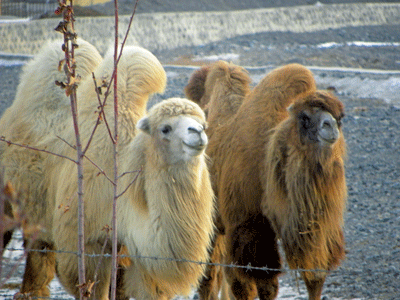
What can you say when arriving at your hotel, the first thing you see is a huge Louis Vuitton boutique next to the building? Or that the stylish spa nearby used products from France, and when tried out by spa junkie Janice, was pronounced “one of the best treatments I ever had”.
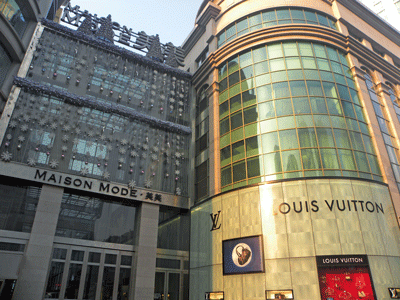
Except for the spotty telecom-munications situation, the result of a government clampdown due to bitter ethnic clashes between the native Uygurs and Han Chinese last July, Urumqi remains one of China’s economic bulwarks in its Far West. Its vast reserves of oil and natural gas, which are still far from developed, account for Beijing’s keen interest and firm hand in running affairs in this remoteness.
Add to that the Central Government’s insistence that Xinjiang, which is several time zones removed from the capital, runs on Beijing time. If it’s 9am in the Chinese capital, it’s actually 7am in Urumqi.
For the time-strapped traveller, the Xinjiang Autonomous Region Museum is an excellent place to get one’s bearings on the scope and richness of Urumqi’s heritage and ethnic diversity (56 nationalities, led by the Uygurs, at last count). A recent US$13 million renovation has produced 10 brand-new halls with unique exhibits sporting lengthy captions, both in Chinese and English, which are a must see for archeology aficionados.
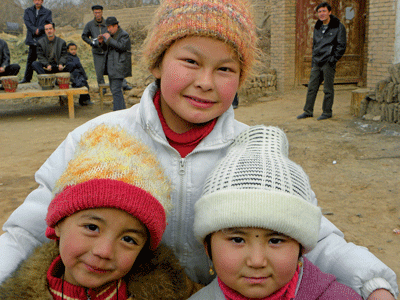
Jack Ho, the heaven sent tour guide we lucked into when booking tours at the hotel’s travel desk, arranged that we be taken around by “Ms Zhang”, whose knowledge of the museum’s pride and joy, the mummy collection, was amazing for its depth and erudition. As she lovingly pointed out a detail here and a detail there, it seemed she regarded all these long dead people as good friends and not merely dessicated subjects of scrutiny.
It was only in the late 1980s when these perfectly preserved bodies, estimated to be 4,000 years old, began appearing in the inhospitable Taklamakan desert in northwestern Xinjiang. The mother lode, Small River Cemetery No. 5, yielded some 200 mummies, bearing reddish-blonde hair and European features, found buried in upside down boats set in cemeteries ringed by forests of wooden stakes.
A recent article in the New York Times described these primitive palisades to be phallic symbols, “signaling an intense interest in the pleasures or utility of procreation”.
The report went on to reveal that more fertility symbols accompanied the graves’ occupants, reflecting the importance attached by the community to procreation.
Most famous of these unearthed villagers is the so-called “Beauty of Loulan”, who was dressed in shades of brown and had a basket with grains of wheat laid next to her head. She died at about age 40, and an artist’s recreation portrays her with a finely chiseled face and dark eyes. Her glass casket takes pride of place in the exhibit, and a mannequin, styled to represent her, welcomes visitors at the entrance of the mummy hall, wearing a robe of native material and a half smile.
Kashgar, location of the poignant film The Kite Runner, deserves a separate trip that could not be accommodated into our schedule, so we settled for a whole-day tour to Turpan, which Jack assured us, would give us a peek into the Uygur culture.
Departing Urumqi at the crack of dawn, Janice and I immediately fell back into sleep, leaving Jack and the driver to converse as the car zoomed along smooth highways knifing through vast wind farms – dotted with countless turbines – and the velvety blue Tianshan Mountains that stretched all the way to Kazakhstan.
At 154m below sea level, Turpan boasts dubious twin titles as the second lowest place on earth, after the Dead Sea, and China’s hottest area, with the highest recorded temperature in summer at 49 degrees Celsius. But since this was January and the dead of winter, it was a whole different scenario.
But even in such harsh conditions, man has been able to survive, and the karez, (a particularly Central Asian irrigation technique developed in Xinjiang, Afghanistan and Iran) of drawing up water from enormous underground reservoirs, is an example of his ingenuity.
Down through the centuries, the Uygurs perfected the karez, using long underground tunnels running an incredible 5,000km, to channel snowmelt from the Bogda Mountains to the farmlands. It is this ancient piece of engineering, all done by hand, that Turpan owes its very existence to.
We were admiring the workings of a karez when, as serendipity would have it, we met a friendly local, who invited us to a relative’s wedding in his village. It didn’t take us two seconds to accept, the words “photo op” exploding in our brain. And if there was a bit of breakfast thrown in, we also didn’t mind.
With Jack interpreting throughout, we got our pictures, including a couple of him and Janice dancing with the townsfolk to sinuous sounds produced by a home-grown band; a nice meal of freshly made noodles with all the raisins one could munch; and an offer to enter a wholesale dealership for nuts and raisins to distribute in the Philippines.
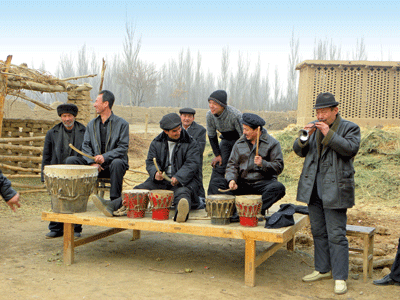
Turpan was one of the legendary oases along the Silk Route, providing the business travellers of that time much needed respite from the rigours of being on the road (sounds familiar?). Its grapes, melons, plums and dried produce have found their way to markets and supermarkets around China and the world.
If there is a desert city to visit, it should be the Jiaohe Ruins, which is about 8km from Turpan. Built as a garrison during the Han dynasty, it is so well preserved that one can surmise from many of the shapes of the structures what these were originally used for. Being the low season, we had the entire fortress to ourselves, which was magical especially when sunset cast a golden glow on the ancient battlements.
That certainly beats looking at a computer screen anytime.
HOTEL CHECK URUMQI - SHERATON
WHAT'S IT LIKE? The Sheraton is the only remaining international hotel brand in Urumqi when previously there were the Kempinski and Holiday Inn. The lobby can be quite overwhelming with its soaring ceilings. But before going any further, one is politely asked to pass his/her belongings through the scanner to the right of the entrance, a precaution introduced after the civil disturbance of July 2009.
The Link at Sheraton Powered by Microsoft, the chain’s latest signature product equipped with free Wi-Fi and Internet-connected computers to enable guests to be connected at all times, occupied a forlorn looking corner on one side of the hall. Due to Urumqi’s limited internet and IDD services, the computers have been removed until things normalise.
WHERE IS IT? From the Urumqi Diwopu International Airport the journey to the city centre takes about 25 minutes. The hotel is located along a major thoroughfare and is next to the swankiest mall in town, Maison Mode (both share the same owner), a replica of the original one in Shanghai.
The Xinjiang Autonomous Region Museum is a 10 minute walk away (accessible through Maison Mode), while the must visit International Grand Bazaar is a 15-minute ride away.
HOW MANY ROOMS? There are 398 guestrooms and suites in the following categories: Deluxe, Business Deluxe, Executive Deluxe, Executive Premier, Executive Premier Suite, Ambassador Suite and Presidential Suite. These range from 40sqm to 256sqm, while executive rooms occupy floors 26 to 32.
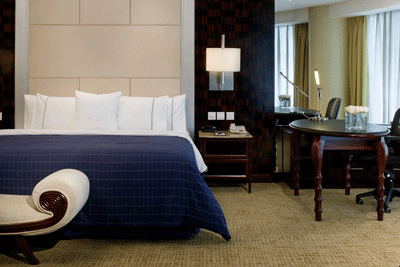
ROOM FACILITIES My companion and I were provided a Deluxe Twin Room, featuring floor-to-ceiling windows that looked out on the wide boulevard and which we kept open throughout our entire stay as the heating system proved too overpowering, Sheraton Sweet Sleeper Beds, a well lighted shower and bath with a gigantic oval mirror, 32-inch flat TV with satellite channels, coffee and tea-making facilities, hairdryer, radio/alarm clock, electronic safe, iron and ironing board and ergonomic work chair. A pouch containing The China Daily was hung on our doorknob each morning. Had the internet been up and running, we would have been charged CNY60 (US$8.78) a day.
ROOM HIGHLIGHTS The room’s spic and span ambiance and smart navy checked duvets. We thought housekeeping did a thorough job of tidying up after us.
RESTAURANTS AND BARS Café Oasis serves a sizeable breakfast buffet that rotates some of the selections during the week. House of Treasures specialises in Cantonese fare, but prepare to be disappointed if your favourites may not be available, which is what happened when we ordered. The wait staff, while exuding warmth, were inattentive and unsure of themselves when interacting with us. Forbidden City also serves Chinese, while Yakexi Halal tempts with Middle Eastern fare. The Lobby Lounge in the center of the lobby seemed to be one of the city’s social hubs – it never lacked for a crowd.
BUSINESS AND MEETING FACILITIES Over 1,400sqm of events space comes from the 800sqm grand ballroom, three function rooms and two boardrooms.
LEISURE FACILITIES Health club, spa offering massage until the wee hours and indoor heated pool with a skylight.
PRICE Internet rates for a mid-week stay in June start from CNY1,050 (US$153.80) for a Deluxe Room.
CONTACT 669 Northern Youhao Road, Urumqi, Xinjing 830000, China, tel 86 991 699 9999, www.sheraton.com
VERDICT: The predictable Sheraton service quality made for a comfortable stay. The location was excellent.
FAST FACTS
Xinjiang Autonomous Region Museum
Xibei Road
Opening hours: 10am to 1.30pm and 3.30pm to 6.30pm
Jack Ho
Tour guide
Tel 86 13999126864, [email protected]
Jiaohe Ruins
8km from Turpan town centre








